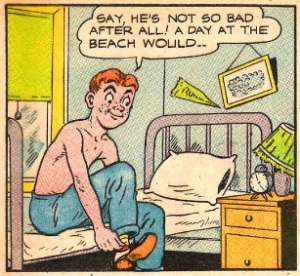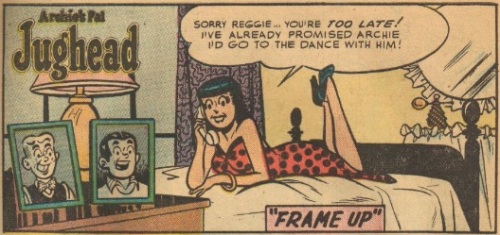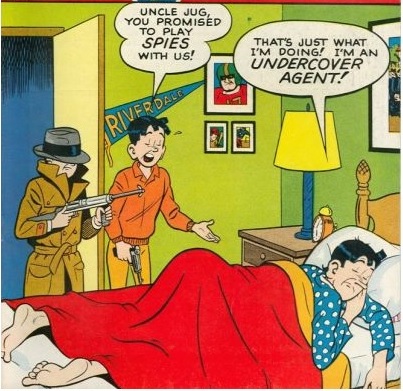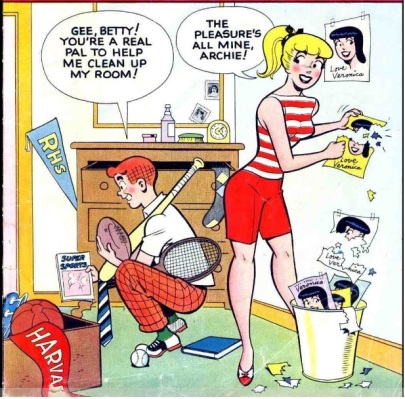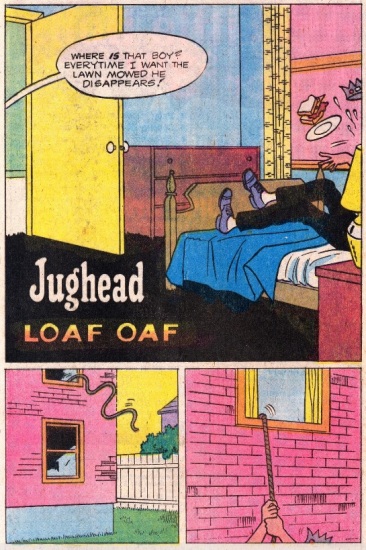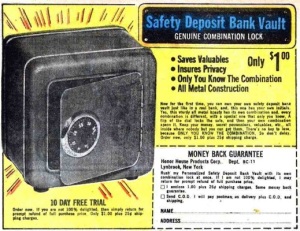As one of the few comic book series to span the entire postwar period and address the unique experiences of America’s teenage population, Archie comics offer an excellent opportunity to assess certain features of teen bedroom culture. Although Archie and his pals have always been considered “square” in comparison to other types of postwar youth culture, locked as they were in a mythic age of small towns and wholesome Eisenhower-era values, their madcap adventures provide us with an intriguing glimpse into the idealized teen bedroom.
Archie and his friends made their first appearance in Pep Comics in December 1941. Eager to capitalize on the popularity of Mickey Rooney’s Andy Hardy films, publisher John L. Goldwater, with assistance from writer Vic Bloom and illustrator Bob Montana, brought the first stand-alone Archie comic, the fittingly titled Archie Comics, to American newsstands in the winter of 1942. Its protagonist, Archie Andrews, is an average middle-class American teenager, an affable redheaded boy whose circle of friends includes a pampered princess named Veronica Lodge, a wholesome girl-next-door type named Betty Cooper, a hamburger-obsessed slacker named Jughead Jones, and a vainglorious jock named Reggie Mantle. Archie and his pals attend high school in the fictional town of Riverdale, and although most of their social activities tend to take place in the hallways and classrooms of Riverdale High or various hangouts downtown—Pop Tates’ malt shop is an especially popular setting—several stories are set inside their bedrooms. Due to their economic and demographic circumstances, Archie and his friends were uniquely qualified to preside over rooms of their own. All of them were from either middle- or upper-class families, and for some strange reason not one of the main characters had a brother or sister. Archie, Jughead, Betty, Veronica, and Reggie, in short, had both the space and the requisite wealth to take an active part in teen bedroom culture during the postwar years.
An early glimpse into Archie Andrews’ sleeping quarters. The “he” Archie is referring to here is Soviet leader Joseph Stalin. This strip ends with Archie being called before the House Un-American Activities Committee (HUAC). Taken from “Musclebound Madness,” Archie, July-August 1947.
Visually speaking, the teen bedrooms that were found in Archie comics were drawn in such a way as to reflect the interests and hobbies of its owners and reinforce the primary features of their personalities. Archie’s room, for example, often features pin-ups of Betty and Veronica, the two girls who most often vied for his attention. Similarly, the walls of Veronica’s room are often decorated with pictures of Reggie and Archie, the two boys who most often vied for her attention. Jughead’s room, on the other hand, sometimes features pin-ups and framed portraits of food, including pork chops and hamburgers. This is entirely in keeping with Jughead’s persona, as his character is often portrayed as being both food-obsessed and asexual. Reggie Mantle’s room, meanwhile, is occasionally shown as having a giant mirror on the wall, a decor accessory that nicely illustrates his narcissistic tendencies.
The bedrooms Archie and his friends preside over also reinforce traditional ideas on gender and sexuality—especially during the 1940s, 1950s, and early 1960s, the years preceding the emergence of the counterculture. Rooms belonging to female characters are almost always decorated in a stereotypically feminine manner, featuring plenty of pastel colors and frilly decorative items. And of course it is exceedingly rare to see a girl’s bedroom that doesn’t feature an elaborate vanity, which suggests that the rooms occupied by Betty and Veronica were used first and foremost as a means of attending to various beautification rituals. Although telephones were occasionally shown in the rooms of Archie and some of his other male friends, the writers and illustrators responsible for creating these comics usually crafted bedroom scenes which reinforced the notion that girls were more likely to have telephones in their rooms than boys.
A glimpse into Veronica’s bedroom. Note the frilly vanity in the background, the photos of Archie and Reggie, and, of course, the telephone. Taken from “Frame Up,” Archie’s Pal Jughead, December 1954.
Rooms belonging to boys, conversely, are portrayed in a much more Spartan manner, oftentimes emphasizing utilitarian designs based on traditionally masculine pursuits. The pastel colors and frilly bedroom accessories prized by Betty and Veronica are nowhere to be found in the rooms of Archie, Jughead, and Reggie, as the boys most often preferred to decorate their rooms with familiar symbols of masculinity, including pin-ups of girls and athletes, trophies, and high school banners.
Even Jughead, the least athletic member of Archie’s gang, decorates his room with sports-related pin-ups and banners. Taken from the cover of Jughead, March 1966.
Similarly, boys’ rooms are almost always furnished with a desk, an important educational tool that is rarely ever seen in the rooms of female characters. This suggests that Archie, Jughead, and Reggie were expected to use their rooms as a means of attaining various educational goals, whereas Betty and Veronica were expected to use their rooms to attend to their physical appearance in an attempt, one presumes, to prepare them for their future roles as housewives and mothers.
The rooms that showed up in Archie comics also rarely ever played host to any serious acts of transgression. The teen bedroom was almost always conceived as a homosocial space, as male characters and female characters didn’t normally interact there in a prolonged or meaningful manner. The teen bedroom remained a wholesome space where pornography consumption, masturbation, and sexual experimentation were conspicuously absent, even after the sexual revolutions of the 1960s and 1970s began changing the sexual mores of the very teens and pre-teens who tended to read Archie comics.
I’ve gone through a lot of Archie comics over the past few years and this is the only image I’ve seen in which a male and female character are shown spending time alone in the bedroom. Taken from the cover of Archie’s Joke Book, October 1960.
Similarly, the teen bedroom’s reputation as a place in which to store and consume drugs and alcohol did not often find expression in Archie comics. Male and female characters listened to records, ate food, and studied in their rooms, but one would be hard pressed to find a strip in which Reggie downs shots of tequila in his room or Betty Cooper cracks a window in her room while smoking a joint. The closest the writers of Archie comics ever came to discussing the dangers of the teen bedroom was a strip in which Jughead uses his bedroom window as a means of escaping from the family home. It should be noted, however, that Jughead doesn’t leap out of his window in order to break curfew or attend a high school party; instead, he does it to avoid doing household chores. Again, this is entirely keeping with Jughead’s reputation as a slacker rather than a comment on the teen bedroom’s value as a means of fleeing parental authority.
Jughead beats a hasty retreat through his bedroom window. His aversion to chores is such that he ends up hiding in a sewer pipe, a dumpster, and his neighbor’s dog house. Taken from “Loaf Oaf,” Laugh, November 1979.
Ultimately, the people responsible for writing Archie comics offered a view of teen bedroom culture that was both familiar with contemporary trends and wildly anachronistic (which, come to think of it, is a somewhat apt description of Archie comics as a whole). On the one hand, they were quick to acknowledge that bedrooms were a prominent part of postwar teen culture and that identity issues often shaped how the average teenager decorated his or her room. On the other hand, the various activities Archie and his friends performed in their rooms would cause even the most obtuse among us to question the writers’ familiarity with contemporary teenagers. Obviously, the writers of Archie comics weren’t trying to attract the same audience as Zap or the Fabulous Furry Freak Brothers, but surely they could have presented a more complicated view of teen bedroom culture in which drug use, sex, and other non-wholesome topics are at least occasionally broached.
Interestingly enough, this task was left to some of the companies that advertised in Archie comics, many of whom ran ads for miniature vaults and safes disguised as books that promised to keep all sorts of teenage secrets “safe” from other family members.
It’s interesting to imagine what Archie would have kept in his own bedroom safe. A lock of Veronica’s hair? A “going steady” pin for Betty? An eight-ball of crystal meth? These ads were taken from Archie’s Joke Book, October 1960, and Archie’s Gals & Pals, February 1968, respectively.
Who’s to say what kind of things would have been stored away in these no doubt shabbily built products? Whereas one teen might have kept a diary and some assorted keepsakes in his or her “secret book safe,” another teen may have used it to hide cigarettes, drugs, or some other contraband item that ought not fall into the wrong hands. Either way, the folks who built and sold these products understood that even if Betty Cooper wasn’t going to smoke a joint in her room, there was a good chance that some of the teenagers who actually read Archie comics may have been inclined to do so—and that they probably needed a safe place to hide their stash.
A controversial scene from a holiday-themed Archie comic in which our ginger hero ingests three hits of acid and interacts with an elf/hallucination named “Steve.” Taken from “The Return of Jingles,” Archie’s Christmas Stocking, December 1963.
NOTES
Framed photos of Veronica and/or Betty show up in Archie’s room in “The Reel Thing,” Jughead, December 1968; “Instant-Mania,” Everything’s Archie, August 1974; “Late Fate,” Life With Archie, August 1980. Framed photos of Reggie and/or Archie show up in Veronica’s room in “Volley Folly,” Reggie and Me, October 1966. Jughead’s food-related décor choices can be seen in “Late Fate,” Life With Archie, August 1980. Reggie’s massive wall mirror can be found in “Sight Delight,” Reggie’s Wise Guy Jokes, February 1969.
The prevalence of vanities and traditionally feminine décor choices can be found in “Belle Telephone System,” Laugh, June 1963; “Disc-gusted,” Laugh, January 1965; “Recipe for Romance,” Betty & Veronica Double Digest, June 1989.
Athletic items are used for decorative purposes in “Safe Unsound,” Archie’s Pal Jughead, April 1957; “Farced Labor,” Laugh, July 1959; “Sick, Sick, Sick!” Laugh, July 1960; “Weak End Guest,” Laugh, November 1963; “Snooze Ruse,” Life With Archie, July 1986; “The Late Starter,” Betty & Veronica Double Digest, June 1989. Study desks figure prominently in “Tape Trouble,” Reggie and Me, October 1966; Jughead, December 1968, front cover; “Gift Rift,” Laugh, November 1974; “Adult Education,” Betty & Veronica Double Digest, June 1989; “Test Rest,” Laugh, June 1990.

